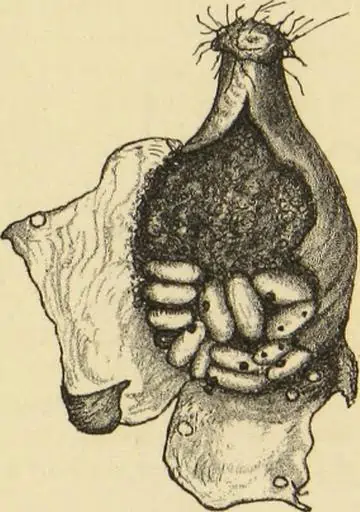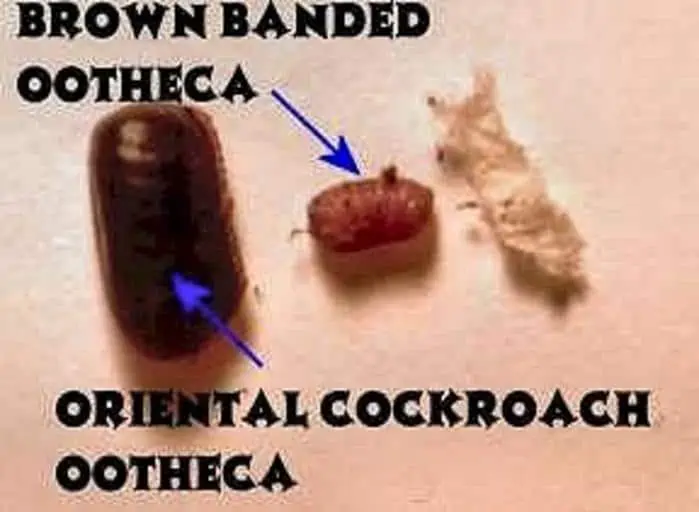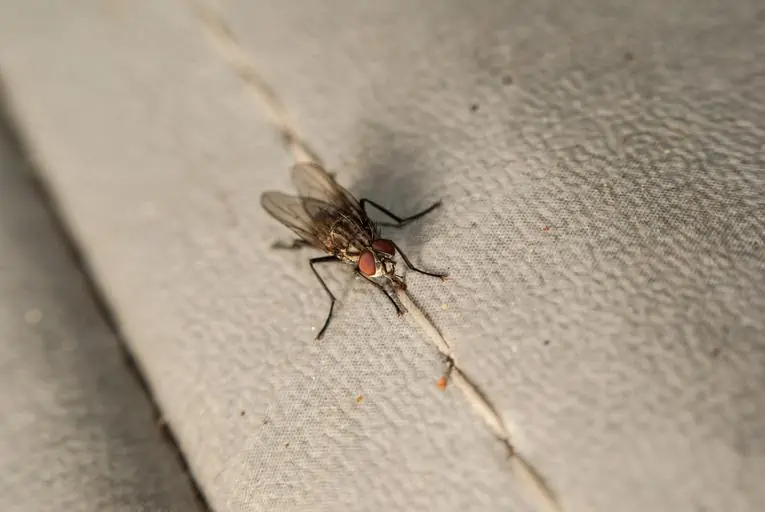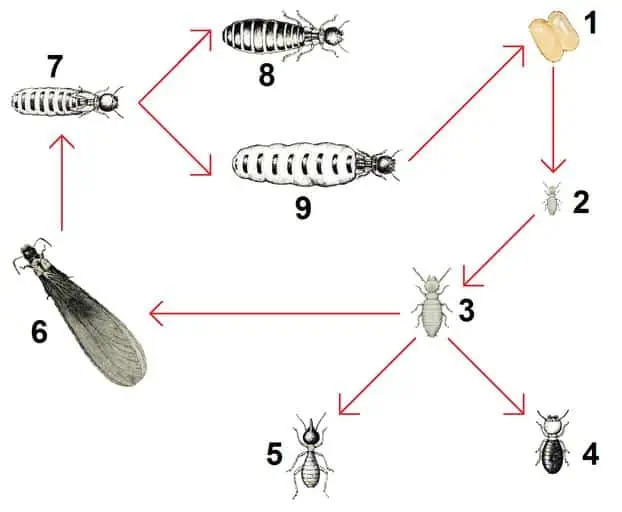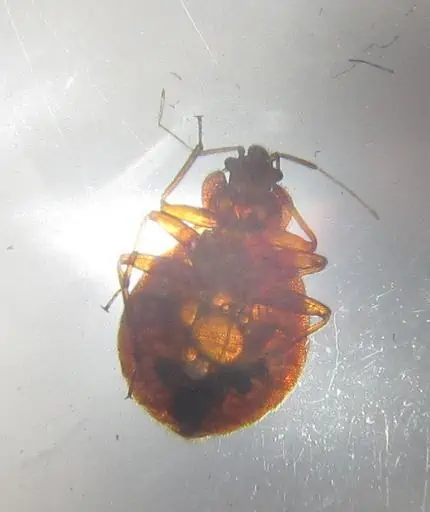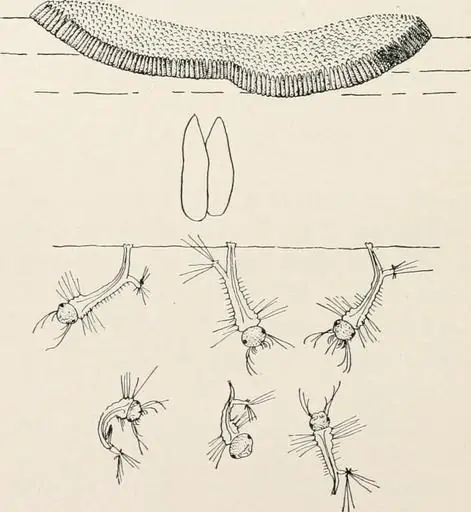Insect egg sacs are a common sight in many homes. However, they can sometimes be difficult to tell apart, especially if you’re not familiar with the insects that lay them. In today’s article, we are going to provide a guide on insect egg sac identification in an effort to help you identify what kind of insect egg sacs you have in your house and how to deal with them.
Let’s get started.
Contents
Which Types of Insect Egg Sacs Are Most Common?
Spider egg sacs are commonly thought of most when we think of egg sacs.
When it comes to insect egg sac identification, there are a few types of insects you may be dealing with. Insect egg sacs can be found in many places around your home, especially during warmer months. These sacs are made by insects to protect their eggs and give them time to hatch. They are usually found in cracks or crevices, but sometimes they can be seen on walls or ceilings as well.
Insect egg sacs come in many different shapes and sizes depending on the type of insect that laid them. Most of the time a pest control expert can help you identify what kind of insect is living in your home based on what type of egg sacs are present. Different types of insects lay different types of egg sacs, so this can give you a good idea about what kind of infestation you might have.
However, if you’re interested in do-it-yourself methods of pest control then using your own insect egg sac identification guide such as this one can help you determine the best practices for getting rid of specific pests.
Of course, not all pests have egg sacs, and you can narrow many pests down simply by knowing which insects leave behind egg sacs and which ones do not.
With that being said, most insects do lay eggs. However, some insects lay eggs in clusters, or even lay just a few eggs at a time. Other pests, like spiders, for example, lay eggs in a sticky web-like substance known as an egg sac.
This egg sac is designed to protect their offspring and to allow the eggs time to hatch without being disturbed.
Insect egg sacs are a sign that you have an infestation of pests in your home. They can be dangerous and should be dealt with quickly by either you or a pest control professional.
Insect egg sacs are not always dangerous, but they are a sign that you have an infestation of pests in your home. It is possible to find more than one type of insect egg sac in your home as well, but this is rare. Still, this is why insect egg sac identification can be so important.
It is possible for any household to have more than one type of insect egg sac in their home at a time, as mentioned. Pests like bed bugs and fleas lay these eggs in different places around the house, so it’s possible to find multiple types of insect eggs in different rooms of your house if you’re dealing with multiple infestations at once.
Furthermore, finding insect egg sacs in your home means that the pests are reducing and if the problem is not dealt with, it will soon get worse.
With that noted, let’s talk about the most common types of insects that may have led to you looking for an insect egg sac identification guide in the first place.
What Are Insect Egg Sacs
Egg sacs are designed to protect the eggs, as the above diagram shows.
Insect egg sacs are the protective covering that insects lay their eggs in. Some female insects or pests will lay their eggs in an egg sac and then guard it until they hatch. Other insects will leave their egg sacs once they have been created. Outside, insect egg sacs are typically found on plants, under bark, beneath the debris, in eaves, or along your home’s siding. Indoors, they are often found in basements, behind furniture, in areas with lots of debris or clutter, under cabinets or below sinks, and even in closets.
Each type of insect has its own unique way of laying eggs, which means that you will need to know how to identify each type of insect egg sac in order to properly control and remove them from your home or business.
But why do insects lay eggs in egg sacs that would require you to use egg sac identification? Well, there are two main reasons why insects lay their eggs in egg sacs:
Protection: Insects use egg cases as a form of protection for their young from predators and from other dangers that could harm them before they hatch. This includes protecting not only from predators but also from the elements like rain, wind, ice, and even from ultraviolet rays and other environmental factors that may be detrimental to their survival rate.
Faster development: Insects also use egg cases as a way to speed up the process of hatching because it allows them to develop faster than if they were left exposed to the elements or outside of an exoskeleton shell.
The most common types of insect egg sacs you may need to identify include:
- Spiders
- Cockroaches
- Flies
- Termites
- Bed Bugs
- Mosquitos
- Fleas
Let’s talk now about the above most common types of pests that lay insect egg sacs in order to best use egg sac identification to determine which pest you are dealing with.
Spider Insect Egg Sac Identification
Black widow spider egg sacs usually have bumps or ridges.
Although we are talking about insect egg sac identification, spiders are not true insects. In fact, spiders are arachnids, which means that they have eight legs, two body parts, and no antennae. They also have fangs, which they use to inject venom. Spiders are closer genetically to scorpions and ticks than other arthropods.
Like other insect eggs, spider eggs are laid in a sac or case created by the mother spider. The egg sacs are usually white or pale yellow and can be found hanging from trees, shrubs, clutter, walls, or buildings. Some species of spiders create silken cocoons around their egg sacs to protect them from predators.
The number of baby spiders in each egg sac depends on the species of spider that has laid them. Some species may lay as few as 50 eggs while others may lay up to 1,000 eggs at once!
In most cases, you can simply pick up a spider egg sac with your hand or tissue and place it into a plastic bag for disposal outside of your home if you want to get rid of it. However, some species of spider can be venomous, so this is not always recommended.
While a spider egg sac is not always easy to see, it can be identified by its shape, color, and size. The shape of an egg sac differs from that of a spiderling, which is typically round and roughly the same size as the spider. The egg sac of some species, such as the nursery web spider (Pisaurina mira), is bulbous in shape and resembles a jellyfish more than an insect egg case. Other species produce long, narrow sacs that resemble tiny mummies.
The most common color of an egg case is cream or white. Some species produce brightly colored sacs with stripes or spots, while others produce brown or black sacs with splashes of red or orange. In some cases, the coloration may be irregularly distributed across the surface of the case.
Egg cases are produced by female spiders who have already mated with males and fertilized their eggs before storing them away for later hatching. They range in size from less than 1 inch (2.5 cm) long in some species to over 6 inches (15 cm) long in others depending on whether they are producing one or multiple offspring at a time.
Cockroach Insect Egg Sac Identification
Roach eggs are often called Ootheca.
Cockroaches are insects that can be found almost anywhere in the world. They are a nuisance and can even cause health problems when they enter your home. Cockroach egg sacs are laid by the female roach to produce eggs, which will eventually hatch into baby roaches.
These insect egg sacs can be identified using insect egg sac identification. They are small white balls that contain up to 30 eggs. They have a sticky outer layer, which helps keep the eggs together until they hatch.
Each female roach lays up to 30 eggs at one time, so there can be a large number of cockroaches living in one area at any given time. This leads to larger infestations and makes them harder to eliminate from your home once they’ve moved in.
The best way to get rid of roach egg sacs is by using an insecticide that specifically targets them. You might also choose an insecticide that contains an insect growth regulator, or IGR.
When looking for cockroach egg sacs and using insect egg sac identification, there are a few places you can look. These egg sacs can be found anywhere in your home, but they are most often found behind the fridge or stove. You can also find them in cabinets and behind appliances.
Fly Insect Egg Sac Identification
House fly eggs look like very small grains of rice.
Flies are a very common type of insect in many parts of the world. They can be found on every continent and there are approximately 110,000 different species.
These pests can be found in just about every type of habitat, except polar regions. They are typically found near water sources or other moist areas where they can lay their eggs.
There are usually between 50 and 100 eggs inside each fly egg sac. Once these eggs hatch into larvae, they may go through up to 10 different stages before becoming adults. It can take anywhere from two weeks to six months for this process to happen depending on the type of fly and its environment.
Fly egg sacs are small, elongated, and tan or brown in color. They can be as small as a grain of rice or as large as a pea. Each sac contains anywhere from 100-300 eggs.
If you find one of these little guys in your home, it’s important to take action immediately because these eggs can hatch quickly! To remove them from your home, simply vacuum them up using an attachment designed for pet hair or use a broom or brush to sweep them into a dustpan and then dispose of them in the trash or flush them down the toilet.
Termite Egg Identification
Termite eggs are often small and cream-colored.
Termites are a group of social insects that eat wood, generally in the form of dead trees and plants. Termites are considered a pest by most people because they can cause extensive damage to structures.
Termite eggs are white or cream-colored. The eggs have an oval shape and are about 1/16 inch (.15 cm) long. The eggs may be visible through the surface of the sac or they may be hidden inside small holes in the top of the sac.
Termite eggs are laid by queen termites during their reproductive cycle. If a colony has more than one queen, each will lay separate egg sacs at different times during their reproductive cycles so that there is no overlap in the number of workers present in the colony at any given time (this helps prevent competition between queens). After laying her eggs, each queen will seal her sac shut with saliva and mud before moving on to find another place to lay more eggs (usually within 24 hours).
It’s possible to spot termite egg sacs in your home or yard, but only if you know what you’re looking for.
Termites are a danger to any wooden structure. They feed on wood and can cause severe damage to your house.
The best way to prevent termites from damaging your property is to take precautions before they become established in your home or building. You can also treat an existing infestation with an insecticide containing chlordane or other chemicals approved by the Environmental Protection Agency (EPA).
You can also prevent termites and their eggs by keeping the soil around your house free of dead trees and plants, as these items provide food for termites. We also suggest keeping the grass cut short to make it more difficult for termites to move through your yard unnoticed. If you do notice signs of termites or termite egg sacs, it’s often best to contact a professional pest control expert before the problem gets out of hand.
Bed Bug Insect Egg Sac Identification
Bed bug eggs are small but can be seen with the naked eye.
Bed bugs are small, flat, wingless insects that feed on the blood of humans and animals while they sleep. Bed bugs are considered a nuisance pest more than a public health pest as they do not spread disease and do not cause physical harm to humans, aside from rashes or bumps caused by their bites. With that said, in rare cases, bed bugs can cause allergic reactions in people who are sensitive to them.
Adult bed bug females lay one to five eggs per day and may lay 200 or more eggs during their lifetime. Eggs are white, light yellow, or brown in color, about one mm long, and oval-shaped. Eggs develop through three stages including egg, larva, and nymph before the larva becomes an adult. Newly hatched nymphs are clear-colored with blackish-brown heads and develop through five stages (instars) before maturing into adults.
Bed bug eggs can hatch after about six days of incubation, though some take up to two weeks. Newly hatched nymphs will molt within hours after emerging from their eggs and grow quickly over the next few days reaching adulthood by day 35 if there is ample food (aka blood hosts) available for them.
Bed bug eggs are white, oval, and about the size of a small grain of rice. They can be found in clusters on bed sheets, mattresses, and other surfaces where bed bugs may hide during the day.
The best way to get rid of bed bug egg sacs is by eliminating the source of infestation. This means treating all areas that have been infested with insecticides specifically designed for killing this type of pest. If you’re not sure if you have a bed bug problem or just want to make sure there aren’t any lingering after treatment, call a quality pest control agency for further assistance.
Mosquito Egg Identification
Mosquito eggs cluster at the surface of the water, as shown above.
Mosquitos are small, flying insects that belong to the family Culicidae. They have a pair of wings and three pairs of long, thin legs. Most species have flattened bodies and long proboscises which they use to pierce the skin of their hosts and suck out blood. Female mosquitoes lay their eggs near water sources so that their larvae can drop into the water when they hatch.
The mosquito eggs are laid in a water-soaked gelatinous mass, called an egg raft, which is attached to submerged vegetation or other objects. The egg raft is typically about one cm in diameter but can reach up to four cm. A single female can lay up to 200 eggs at one time, though a single egg raft may contain between 50 and 100 eggs.
Mosquito egg sacs are very small, and they can be very difficult to see. They look like tiny white balls of cotton, or other materials that are similar in color. Some people describe them as looking like grains of rice or poppy seeds, but this is not always the case. It is important to know what they look like so that you can identify them properly before attempting to destroy them.
Each mosquito egg sac contains only one larva, which hatches and is born into stagnant water like ponds, lakes, and sometimes even pools. The larva feeds on the organic matter until it reaches maturity and is able to fly away from its original location in search of blood meals. After it has fed several times, it will molt into a pupa before becoming an adult mosquito again.
It is best to remove mosquito eggs from the water source before they hatch to reduce problems with mosquitoes around your property. This can be done by using a net or by pouring the water out of the container into a bucket or other receptacle that can be emptied outdoors and refilled with fresh water.
If you have an area where there are mosquito eggs, you should treat it with an insecticide. There are several insecticides available for killing mosquitoes including permethrin, pyrethrum, and malathion. You should use these products according to the instructions on their labels to ensure proper coverage and safety when working around children and pets.
Flea Egg Identification
Flea eggs are often extremely small.
Fleas are tiny, wingless insects that live on the blood of animals and humans. They are found all over the world and have been known to affect pets and humans for thousands of years.
If you’re using insect egg sac identification to identify flea eggs, you have a rough time of it. Flea egg sacs are extremely small and difficult to see without the assistance of a magnifying glass. They look like white spheres about one mm in diameter. The eggs are laid by the female flea in batches of 50 to 200, either on a host or in an environment such as bedding or carpeting around the home.
Each female flea can lay up to 50 eggs at a time. If an infestation is not treated quickly enough then it is possible for hundreds of new adult fleas to emerge from this single batch of eggs!
Flea eggs are tiny and almost impossible to see, as we mentioned above. They’re usually white or yellow, but they can also be dark brown or black. They’re often found in areas where fleas tend to hang out, such as behind sofas and on carpets.
The easiest way to get rid of flea eggs is by vacuuming them up. If you have an area that’s infested with adult fleas, it’s likely that there will be many more eggs present. Vacuuming these areas regularly can help prevent an infestation from getting out of control.
A second method for getting rid of flea eggs is by using a spray-on product that contains insect growth regulators (IGRs). These products kill developing fleas by preventing them from molting into adults. They also prevent new eggs from hatching and spreading the infestation further into your home.
How To Control Common Pests Using Insect Egg Sac Identification
Identifying the correct egg sac of the pest you are dealing with can help reduce the chances of dealing with a future infestation by allowing you to find the best methods of control.
Insect egg sac identification is a great way to identify what type of pest you are dealing with, although it’s not always easy to do on your own. However, once you know what kind of insect it is, you can then choose the correct form of pest control to get rid of it.
There are several steps you should take when using insect egg sac identification to get rid of pests, including those listed below.
First, use an appropriate form of pest control containing an insect growth regulator (IGR). IGRs disrupt the development of insects in their eggs and larvae stages. The most common IGRs are hydroprene and pyriproxyfen. They’re used indoors and outdoors on lawns, shrubs, and trees where children play.
Next, keep up with routine home maintenance. Pest infestations often result from poor housekeeping habits such as leaving food out for pets or not disposing of trash properly. Keep an eye out for signs of infestation like dead bugs or rodent droppings, which may indicate that there’s a larger problem at hand that needs professional attention.
We also suggest you keep up with yard maintenance to keep pests at bay. Regularly mowing the lawn will help prevent weeds from growing tall enough to attract pests like mosquitoes or fleas, and mulching lawn clippings will also help keep weeds down by providing nutrients for pests.
Be sure to also remove excess water from your home and yard. Water attracts many types of insects including mosquitoes, ants, and roaches. Keep outdoor drains clear so that water doesn’t build up around them. Make sure gutters don’t clog with leaves or debris so water flows freely through them into drainage pipes. Excessive rain causes water to seep into cracks in walls or under doors which may also encourage bug infestation inside your home as well as outside it.
Be sure you also remove excess clutter where bugs can hide. Pests like to be hidden away in dark corners, so make sure you clean up any messes and keep things tidy. This should include cleaning up storage boxes, removing debris from your yard, and keeping your home tidy and neat.
Seal cracks around windows and doors so that no bugs can get inside your home from outside. If there’s already an opening, try caulking it closed with silicone caulk or foam sealant. This will also help keep cold air out of the home during the winter months!
Last, be sure you use a quality form of pest control year-round to not only get rid of bugs currently causing you to look up insect egg sac identification, but also to keep any future pests from coming around.
Best of luck and thanks for reading!


Jack founded our blog after two decades of working in the pest control industry. His vast experience dealing with a wide array of pests allows him to diagnose issues quickly and get to the heart of pest problems quickly and effectively. He has serviced more than 2,000 homes over his career and there is hardly any pest situation that he has not seen before.

